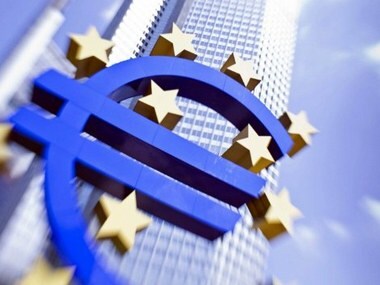ByArjun Parthasarathy
The euro is down over 3.5 percent against the US dollar (USD) and is looking to go down further on the back of debt woes in the eurozone. The Indian rupee is down over 4.5 percent against the USD since 1 August and there are worries that the rupee will depreciate further. The euro’s depreciation is on the cards but will the rupee follow the euro or will it break away to trade on its own fundamentals?
Why will the euro depreciate?
[caption id=“attachment_81297” align=“alignleft” width=“380” caption=“The European currency Euro logo stands in front of the European Central Bank (ECB) in Frankfurt. AFP”]
 [/caption]
[/caption]
The eurozone is the worst affected in the current economic crisis and the euro will have to reflect the weakness. The euro, which had gained over 13 percent against the USD in the last one year, is set to give up all the gains in the coming months as eurozone woes worsen.
The euro, which is currently trading at levels of $1.365, will fall all the way to $1.20, a fall of 12 percent on the back of weakening eurozone fundamentals.
The euro has no support. The debt woes in countries such as Greece, Ireland, Portugal, Spain and Italy have no immediate solution at present. Bond yields of these countries have shot in the recent past even as German bond yields have fallen to record lows on risk aversion.
The rising cost of debt in indebted eurozone countries, coupled with high interest rates and lack of investor support, is hurting these economies. All the indebted countries in the eurozone are adopting austerity measures in order to bring down the fiscal imbalance and to fulfil the terms of bailout by the European Financial Stability Fund (EFSF).
The EFSF was set up with a corpus of 440 billion to lend to indebted nations. The adoption of austerity measures is further pushing the indebted countries into deeper trouble as growth falls off and tax collection comes down due to falling GDP growth.
The second quarter of 2011 saw the eurozone GDP growth come in at 0.2 percent against a growth of 0.8 percent in the first quarter. France GDP growth was flat in the second quarter while German GDP growth came in at 0.1 percent. These two economies grew by 0.9 percent and 1.3 percent in the first quarter of 2011 respectively. The continuing debt woes are likely to push the eurozone into negative growth territory in the second half of 2011.
The fact that the biggest economies in the eurozone - Germany and France - are facing headwinds themselves is preventing firm action to bail out the indebted nations. Germany is facing voter unrest on using German funds to bail out other eurozone countries while France is facing high debt coupled with weak economic growth. French debt-to-GDP at over 80 percent is worrying the markets, as it fears a rating downgrade from its current AAA status.
The European Central Bank (ECB), which has raised rates by 50 basis points (0.5 percent) this year as eurozone inflation was running higher than targeted levels of 2 percent and below, is now under pressure to reduce interest rates due to slowdown worries in the eurozone. The fact that August inflation has remained unchanged month on month at 2.5 percent increases the calls for rate reduction. Lower policy rates in the eurozone will bring down rate differentials with the USD and weaken the euro.
The rupee is on a stronger wicket
The rupee is weakening on sentiments rather than fundamentals. India is not facing a sovereign debt problem as the euro is facing while the country is expected grow at 7.5-8 percent levels this year against eurozone expectations of low or even negative growth.
India’s policy rates, at 8 percent on the repo (the RBI’s overnight lending rate to banks) is far higher than the US policy rate of 0-0.25 percent and the rate differential is wide enough to attract flows into Indian debt. The debt limits of $25 billion is fully utilised by foreign institutional investors (FIIs) while the infrastructure debt limit of $25 billion is unutilised due to issues on holding period, tenor, etc.
The government is addressing this issue and any tweaking of investment regulations on infrastructure debt will see good flows coming into the market. If the RBI can convince the markets it has done enough to contain inflation, which is trending at 9.22 percent levels, the rupee will see a good amount of strength.
India’s current account deficit (CAD) is not a worry as of now. The CAD, which was forecast to go up over 3 percent of GDP last year, ended the year at 2.6 percent of GDP. The April-August 2011 export growth is up by 54.2 percent over last year while imports have growth by 40.4 percent. The trade deficit has grown by close to 15 percent.
Portfolio flows have been positive in the calendar year to date with FII net purchases of equity and debt at $4.5 billion. The external situation is looking reasonably healthy and the outlook for CAD is not highly negative.
A positive tone on inflation by the RBI in the policy review on 16 September 2011 can help the rupee take back some losses.
Arjun Parthasarathy is the Editor of www.investorsareidiots.com , a web site for investors.
)